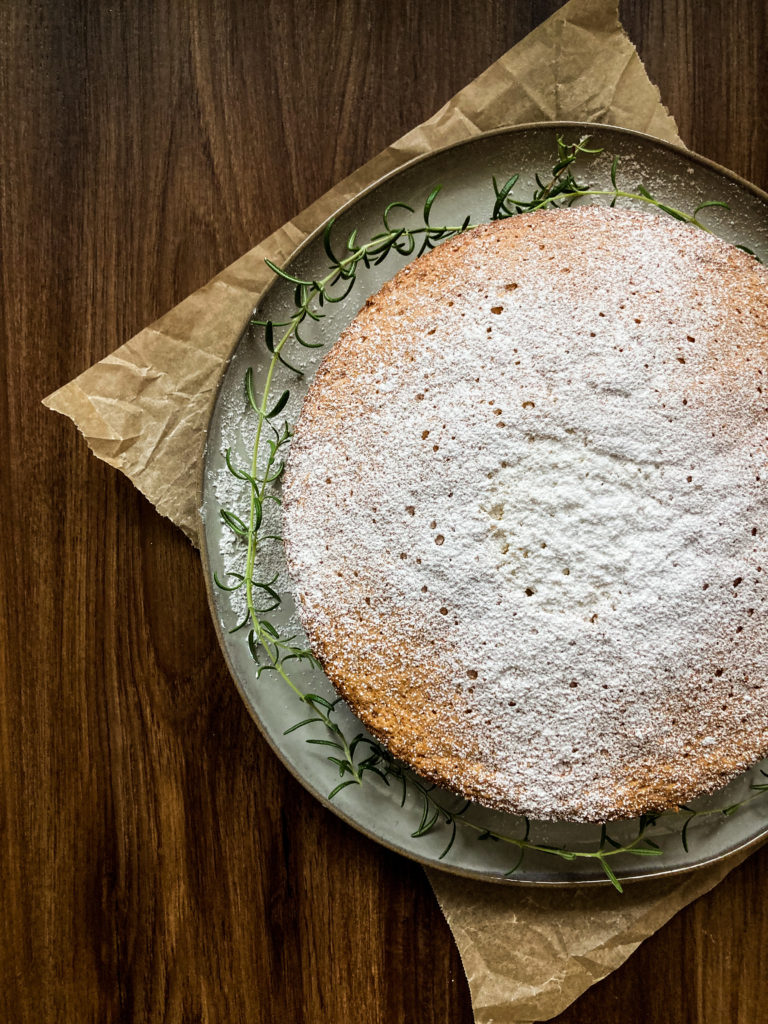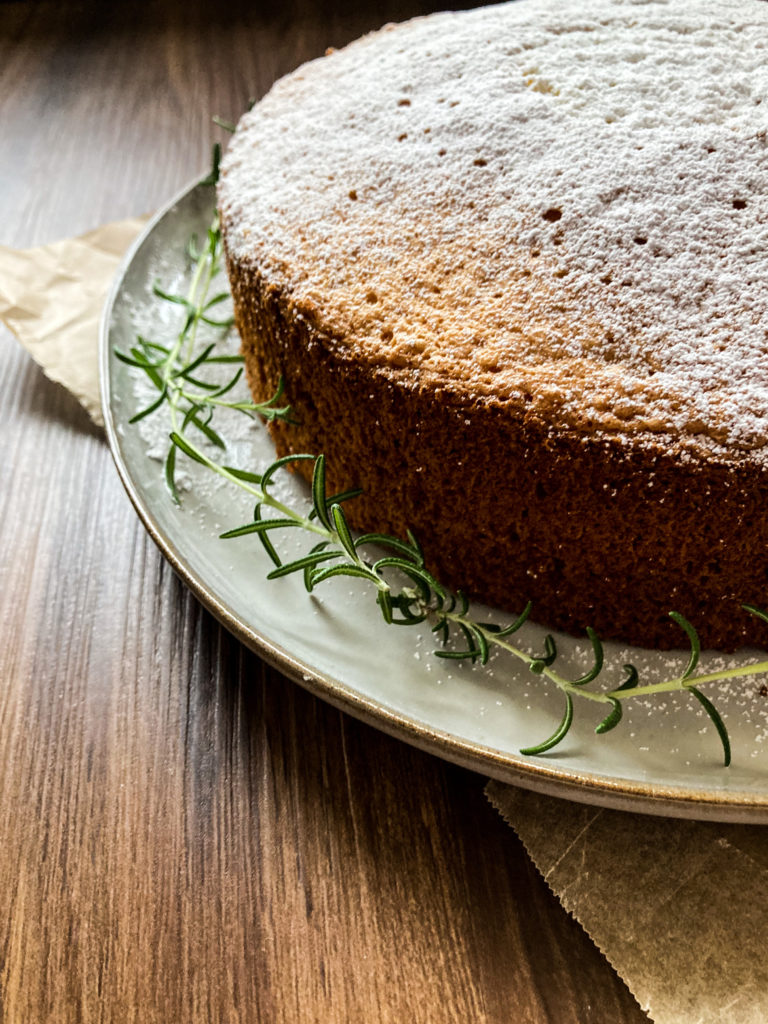Or, biscuit au beurre. Whatever you call it, it is a classic cake, eaten alone or split and filled with various sweet goodies. The summer I spent in Italy, the villa host Helen made a butter spongecake, and filled it with whipped cream and jammy raspberries for a summer grill-out for dessert. I will never forget that delicious, simple cake – or enjoying a piece the morning after (I always woke up early when I was in Italy – maybe the jet-lag?).

It has been a while since I re-visited the spongecake and methods to make this family of cakes. With these, practice makes perfect. For a while, I was experimenting with some gluten-free versions of genoise, made with oat flour. It was a dance to make the flour, whip the egg yolks with sugar, make the soft-peak meringue and clarify the butter. At the end, was it worth it all? Yes. Could it be easier? I think so, yes.
I think too often, we (or at least I do), adhere to tradition or “the way it was supposed to be made” and don’t listen to our guts or intuition. Even with the food scientist in me, I stick to the recipe – and do not modify unless I am 100% certain my way is better…but lately I feel a bit more open to modify and make things my way. I think that is called confidence?

For this recipe, I think I have finally arrived at my ideal spongecake in making and eating. One that can be made in one pan, and then split in two or three layers, and used in more elaborate ways. Or, delicious enough to eat plain with coffee, nibble on while you wait for your pizza to bake for dinner (yeah, Denis and I did that), or steal a slice for an afternoon treat.
For this recipe, I snuck in a small amount of almond flour to nod at the jaconde. I may have motives to make a version of gateau opera soon. I also put in the zest of one cara cara orange, because they are my favorite citrus and it is the season. Rest assured, this recipe is fine with or without those additions. This sponge is stronger than what we think egg-foam based cakes are, so no fear, and feel free make it your own (or just make it as I wrote it below).

A few hacks I’ve come to settle on for spongecake:
-adding half oil and half melted butter will give a more soft, supple cake at room temp (use a neutral oil or play with a flavorful oil, like walnut or olive);
-it is totally respectable to add just a bit of cream of tartar to your meringue for added volume and resilience;
-you can add your sugar, salt, cream of tartar all at once to your egg whites, then whip – no need to gradually add them to your egg whites as they whip;
-using cake flour is best for a tender crumb, but you can get away with using all-purpose in a pinch;
adding your oil/melted butter to the aerated egg yolk and sugar mixture works perfectly well, as opposed to folding in the fat at the end of making the batter;
-cooling the cake upside down not only reminds me of my grandma and her cooling angel food cakes upside-down on ketchup bottles, but really is extra insurance for an airy crumb.
I think that is it, for now. If you own Mastering the Art of French Cooking, you’ll notice the recipe below is very similar to the one on pages 669-670, and you’re not wrong. I’ve just updated with my notes from the years of making this cake and other sponge-cakes (finally all my notes for this recipe, in one spot!). It’s a classic and a keeper.
Butter Spongecake (Biscuit au Beurre) with Orange and Almond
Makes 1 9″ or 10″ cake
- 2 TB (28g) unsalted butter
- 2 TB (25g) neutral oil (grapeseed, canola, etc)
- 2/3 cup (132g) sugar
- 4 large egg yolks
- 2 tsp vanilla extract
- zest of 1 orange (optional)
- 4 large egg whites
- 1/4 tsp fine sea salt
- 2 TB (25g) sugar
- 1/8 tsp cream of tartar)
- 3/4 cup (84g) cake flour (all purpose can also work)
- 1/4 cup (30g) almond flour (optional)
- Line cake pan or springform pan that is 9″ or 10″ in diameter and at least 1 1/2″ tall (I use a 9″ x 2″ round cake pan) with a circle of parchment in the bottom. Leave pan ungreased. Pre-heat oven to 350 with rack in the middle.
- Melt the butter, add the oil. Set aside to cool.
- In a large bowl (large enough for the whole cake batter, ideally one that is wider than it is tall), add the 2/3 cup sugar, egg yolks, vanilla and orange zest.
- In the bowl of a stand-mixer or a bowl that will work with a hand-beater, add the egg whites, sea salt, 2 TB sugar and cream of tartar.
- Into another medium bowl, sift the cake flour and almond meal, then whisk to ensure they are evenly incorporated.
- Now that your ingredients are all measured, make the cake.
- Start by beating the egg yolk/sugar mixture with a whisk until it is pale, fluffy an forms a ribbon that slowly dissolves when you lift the whisk up from the mixture. This will take a few minutes by hand. Add the oil to this light yellow mixture, and mix vigorously to incorporate. Set aside.
- Make the meringue: using a hand mixer or kitchen aid with a whip attachment, beat the egg white mixture until medium-soft peaks, using medium-high speed (#8 on my kitchenaid). Do not beat to stiff/dry peaks, there are harder to fold into the batter.
- Once you have arrived at a medium-soft peak, it is time to fold the final batter. Fold with swift, but gentle confidence! Use the largest rubber spatula you have.
- To the egg yolk mixture, add 1/3 of the whipped egg whites; fold to combine – it is OK if a few white streaks remain, just be sure to get the bottom of the bowl folded up to the top.
- Add 1/3 of the flour mixture, and fold to incorporate.
- Repeat with the remaining meringue and flour, adding in 2 more additions each. Take care to not over-fold the batter, but ensure the bottoms and sides of the bowl are scraped and incorporated.
- Gently pour batter into the prepared pan. Smooth our surface if needed. Gently tap on the counter a few times to remove large bubbles.
- Bake the cake for 25-35 minutes, until the top is light golden and the center is just set – it should be firm to the touch. Do not open open for the first 20 minutes of baking.
- To cool, carefully flip the cake onto a cooling rack to cool upside down. If you want, you can balance the pan edges on some cans, to prevent marring of the top of the cake.
- Once the cake is completely cool, un-mold by running an off-set spatula or tin knife around the edges, and flip onto desired serving plate or back to the cooling rack.
- Enjoy plain, or proceed as needed. Cake will keep at room temperature for a few days, covered or tightly wrapped. Cake can be wrapped well after thoroughly cooling, and frozen for up to a month. Thaw in fridge overnight.

